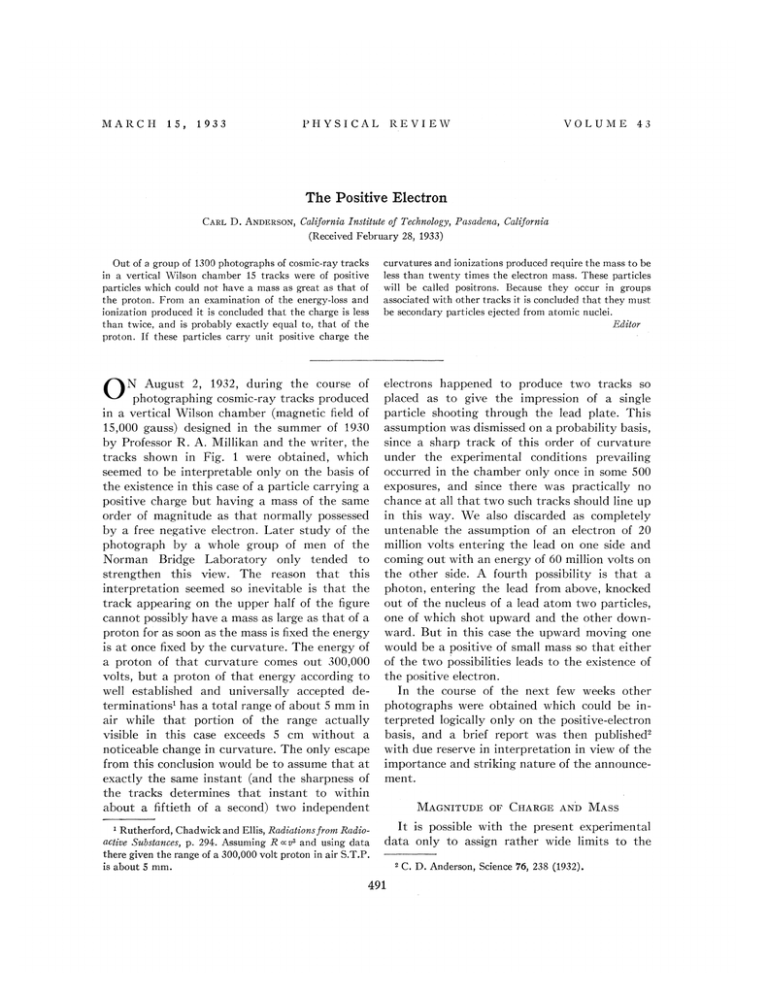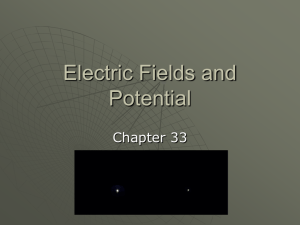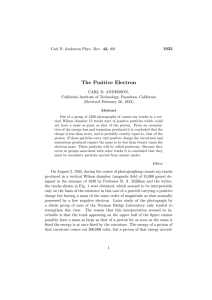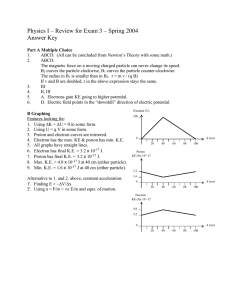The Positive Electron
advertisement

MARC II 15, 1933 I~ I-I VOL UM E 43 Y8 I CA L REV I EW The Positive Electron CARL D. ANDHRsoN, California Institute of Technology, Pasadena, California (Received February 28, 1933) Out of a group of 1300 photographs of cosmic-ray tracks a vertical Wilson chamber 15 tracks were of positive particles which could not have a mass as great as that of the proton. From an examination of the energy-loss and ionization produced it is concluded that the charge is less than twice, and is probably exactly equal to, that of the proton. If these particles carry unit positive charge the in ~[N August 2, 1932, during the course of photographing cosmic-ray tracks produced in a vertical Wilson chamber (magnetic field of 15,000 gauss) designed in the summer of 1930 by Professor R. A. Millikan and the writer, the tracks shown in Fig. 1 were obtained, which seemed to be interpretable only on the basis of the existence in this case of a particle carrying a positive charge but having a mass of the same order of magnitude as that normally possessed by a free negative electron. Later study of the photograph by a whole group of men of the Norman Bridge Laboratory only tended to this view. The reason that this strengthen interpretation seemed so inevitable is that the track appearing on the upper half of the figure cannot possibly have a mass as large as that of a proton for as soon as the mass is fixed the energy is at once fixed by the curvature. The energy of a proton of that curvature comes out 300, 000 volts, but a proton of that energy according to well established and universally accepted determinations' has a total range of about 5 mm in air while that portion of the range actually visible in this case exceeds 5 cm without a noticeable change in curvature. The only escape from this conclusion would be to assume that at exactly the same instant (and the sharpness of the tracks determines that instant to within about a fiftieth of a second') two independent ' Rutherford, Chadwick and Ellis, Radiations from Radio- active Substances, p. 294. Assuming R ccv3 and using data there given the range of a 300,000 volt proton in air S.T.P. is about 5 mm. curvatures and ionizations produced require the mass to be less than twenty times the electron mass. These particles will be called positrons. Because they occur in groups associated with other tracks it is concluded that they must be secondary particles ejected from atomic nuclei. Editor electrons happened to produce two tracks so placed as to give the impression of a single particle shooting through the lead plate. This assumption was dismissed on a probability basis, since a sharp track of this order of curvature under the experimental conditions prevailing occurred in the chamber only once in some 500 exposures, and since there was practically no chance at all that two such tracks should line up in this way. We also discarded as completely untenable the assumption of an electron of 20 million volts entering the lead on one side and coming out with an energy of 60 million volts on the other side. A fourth possibility is that a photon, entering the lead from above, knocked out of the nucleus of a lead atom two particles, one of which shot upward and the other downward. But in this case the upward moving one would be a positive of small mass so that either of the two possibilities leads to the existence of the positive electron. In the course of the next few weeks other photographs were obtained which could be interpreted logically only on the positive-electron basis, and a brief report was then published' with due reserve in interpretation in view of the importance and striking nature of the announcement. MAGNITUDE QI3 CHARGE AND MAss It is possible with the present experimental data only to assign rather wide limits to the 491 ~ C. D. Anderson, Science 76, 238 (1932). POSITIVE ELECTRON charge, an upper limit to the charge less than twice that of the negative electron. It is concluded, therefore, that the magnitude of the charge of the positive electron which we shall henceforth contract to positron is very probably equal to that of a free negative electron which from symmetry considerations would naturally then be called a negatron. 493 twenty times that of the negative electron mass. Further determinations of IIp for relatively low energy particles before and after they cross a known amount of matter, together with a study of ballistic eRects such as close encounters with electrons, involving large energy transfers, will enable closer limits to be assigned to the mass. To date, out of a group of 1300 photographs of cosmic-ray tracks 15 of these show positive particles penetrating the lead, none of which can be ascribed to particles with a mass as large as that of a proton, thus establishing the existence of positive particles of unit charge and of mass small compared to that of a proton. In many other cases due either to the short section of track available for measurement or to the high energy of the particle it is not possible to diRerentiate with certainty between protons and positrons. A comparison of the six or seven hundred positive-ray tracks which we have taken is, however, still consistent with the view that the positive particle which is knocked out of the nucleus by the incoming primary cosmic ray is in many cases a proton. FIG. 2. A pos!tron of 20 million volts energy (Hp=7. 1 &(104 gauss-cm} and a negatron of 30 million volts energy (Hp=10. 2X104 gauss-cm) projected from a plate of lead. The range of the positive particle precludes the possibility of ascribing it to a proton of the observed curvature. It is pointed out that the eRective depth of the chamber in the line of sight which is the same as the direction of the magnetic lines of force was 1 cm and its effective diameter at right angles to that line 14 cm, thus insuring that the particle crossed the chamber practically normal to the lines of force. The change in direction due to scattering in the lead, ' in this case about 8' measured in the plane of the chamber, is a probable value for a particle of this energy though less than the most probable value. The magnitude of the proper mass cannot as yet be given further than to fix an upper limit to it about twenty times that of the electron mass. If Fig. 1 represents a particle of unit charge passing through the lead plate then the curvatures, on the basis of the information at hand on ionization, give too low a value for the energy-loss unless the mass is taken less than FIG. 3. A group of six particles projected from a region in the wall of the chamber. The track at the left of the central group of four tracks is a negatron of about 18 million volts energy (Hp=6. 2)&104 gauss-cm) and that at the right a positron of about 20 million volts energy (Hp = 7.0&(104 gauss-cm). Identification of the two tracks in the center is not possible. A negatron of about 15 million volts is shown at the left. This group represents early tracks which were broadened by the diffusion of the ions. The uniformity of this broadening for all the tracks shows that the particles entered the chamber at the same time. CARL D. ANDERSON From the fact that positrons occur in groups associated with other tracks it is concluded that they must be secondary particles ejected from an atomic nucleus. If we retain the view that a nucleus consists of protons and neutrons (and n- Fj:G. 4. A positron of about 200 million volts energy (Hp=6. 6X $0' gauss-cm) penetrates the 11 mm lead plate and emerges with about 125 million volts energy (Hp =4.2 &&10' gauss-cm). The assumption that the tracks represent a proton traversing the lead plate is inconsistent with the observed curvatures. The energies would then be, respectively, about 20 million and 8 million volts above and below the lead, energies too low to permit the proton to have a range sufficient to penetrate a plate of lead of 11 mm thickness. particles) and that a neutron represents a close combination of a proton and electron, then from the electromagnetic theory as to the origin of mass the simplest assumption would seem to be that an encounter between the incoming primary ray and a proton may take place in such a way as to expand the diameter of the proton to the same value as that possessed by the negatron. This process would release an energy of a billion electron-volts appearing as a secondary photon. As a second possibility the primary ray may disintegrate a neutron (or more than one) in the nucleus by the ejection either of a negatron or a positron with the result that a positive or a negative proton, as the case may be, remains in the nucleus in place of the neutron, the event occurring in this instance without the emission of a photon. This alternative, however, postulates the existence in the nucleus of a proton of negative charge, no evidence for which exists. The greater symmetry, however, between the positive and negative charges revealed by the discovery of the positron should prove a stimulus to search for evidence of the existence of negative protons. If the neutron should prove to be a fundamental particle of a new kind rather than a proton and negatron in close combination, the above hypotheses will have to be abandoned for the proton will then in all probability be represented as a complex particle consisting of a neutron and positron. While this paper was in preparation press reports have announced that P. M. S. Blackett and G. Occhialini in an extensive study of cosmicray tracks have also obtained evidence for the existence of light positive particles confirming our earlier report. I wish to express my great indebtedness to Professor R. A. Millikan f or suggesting this research and for many helpful discussions during its progress. The able assistance of Mr. Seth H. Neddermeyer is also appreciated.






